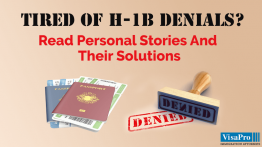Introduction
If you are a U.S. employer hiring new employees, it is essential you complete Form I-9, Employment Eligibility Verification Form, for each new employee. Employers who don’t adhere to the I-9 requirements can anticipate civil and or criminal penalties.
On November 7, 2007, the U.S. Citizenship and Immigration Services (USCIS) announced that a revised Form I-9 is now available. Subsequently, the USCIS announced on November 26, 2007, that all employers must transition to the revised Form I-9 no later than December 26, 2007 and employers who fail to use the revised form will be penalized.
The Revised Form I-9
This revision has removed five documents for proof of both identity and employment eligibility which include:
- Certificate of U.S. Citizenship (Form N-560 or N-570);
- Certificate of Naturalization (Form N-550 or N-570);
- Alien Registration Receipt Card (Form I-151);
- Unexpired Reentry Permit (Form I-327);
- Unexpired Refugee Travel Document (Form I-571).
These five documents were removed because they lack sufficient features to help deter counterfeiting, tampering, and fraud. Additionally, the most recent version of the Employment Authorization Document (Form I-766) was added to List A of the List of Acceptable Documents on the revised form. The revised list now includes:
- U.S. passport (unexpired or expired);
- Permanent Resident Card (Form I-551);
- Unexpired foreign passport with a temporary I-551 stamp;
- Unexpired Employment Authorization Document that contains a photograph (Form I-766, I-688, I-688A, or I-688B);
- Unexpired foreign passport with an unexpired Arrival-Departure Record (Form I-94) for nonimmigrant aliens authorized to work for a specific employer.
This revision seeks to achieve full compliance with the document reduction requirements of the Illegal Immigration Reform and Immigrant Responsibility Act of 1996 (IIRIRA). The IIRIRA mandated the reduction of the number of documents employers may accept from newly hired employees to confirm identity and work eligibility. So what is Form I-9 all about and what is its importance?
What Is Form I-9?
The Immigration Reform and Control Act of 1986 made U.S. employers responsible to verify the employment eligibility and identity of employees hired in the U.S. after November 6, 1986 by completing Form I-9 for all employees, including U.S. citizens.
Note: The Form I-9 is available in English and Spanish. However, only employers in Puerto Rico may have employees complete the Spanish version for their records. Employers in the 50 states and other U.S. territories may use the Spanish version as a translation guide for Spanish-speaking employees, but must complete the English version.
For Whom Must Employers Complete Form I-9?
U.S. employers must have a fully completed Form I-9 for each new employee, unless:
- The employee was hired before November 7, 1986, and has been continuously employed by the same employer
- The employee is providing domestic services in a private household that are sporadic, irregular, or intermittent
- The employee is providing services as an independent contractor (i.e. carrying on an independent business contract by their own means and methods and for whom the employer does not set work hours or provide necessary tools to do the job, or whom the employer does not have authority to hire and fire); and
- The employee is providing services under a contract, subcontract or exchange entered into after November 6, 1986. (In such cases, the contractor is the employer for I-9 purposes; for example, a temporary employment agency.)

What To Do After Form I-9 Is Completed?
I-9 forms are not filed with the U.S. government. Employers need to maintain I-9 records in their own files for three years after the date of hire or one year after the date the employee’s employment is terminated, whichever is later. I-9s need to be retained for all current employees, and terminated employees whose records remain within the retention period. Form I-9 records may be stored at the worksite to which they relate or at a company headquarters (or other) location. The storage choice must make it possible for the documents to be transmitted to the worksite within three days of an official request for production of the documents for inspection.
Note: U.S. immigration law does not prescribe or proscribe storage of a private employer’s I-9 records in employee personnel files. As a practical matter, however, particularly if a large number of employees are involved, it may be difficult to extract records from individual personnel files in time to meet a 3-day deadline for production of I-9 records for official inspection.
Employer’s Responsibility
Section 2 of Form I-9 must be completed within three days of hire. The employer must review and record the documentation presented by the employee. Proper documentation establishes that the employee is authorized to work in the U.S. and that the employee who presents the employment authorization document is the person to whom it was issued. The employer may accept any List A document, establishing both identity and work eligibility, or a combination of List B (establishing identity) and List C document (establishing work eligibility) that the employee chooses to present.
The employer must accept the documents if they appear to be genuine and relate to the employee who presents them. Requesting more or different documentation than the minimum necessary to meet this requirement may amount to unfair immigration-related employment practice. If the documentation presented by an employee does not appear to be genuine or relate to the employee who presents them, employers must refuse acceptance and ask for other documentation from the list of acceptable documents that does meet the requirements. An employer should not continue to employ an employee who cannot present documentation that meets the eligibility and identity requirements.
Employee’s Responsibility
New employees must complete Section 1 of the I-9 on their first day of work. The employee’s signature holds him/her responsible for the accuracy of the information provided. The employer needs to ensure that the employee completes Section 1 in full. No documentation is required from the employee to substantiate Section 1 information.
Testing The Genuineness of The Documents
USCIS does not expect employers to be document experts. However, when reviewing the genuineness of the documents presented by employees, employers are held to a reasonableness standard. It may happen that an employer may accept a document that is not genuine – or is genuine but does not belong to the person who presented it. Such employer will not be held responsible if the document reasonably appeared to be genuine or to relate to the person presenting it. An employer who receives a document that does not appear to be genuine may request assistance from the nearest Immigration field office or contact the Office of Business Liaison.
What To Do With Unauthorized Employees?
It occasionally happens that an employer learns that an employee whose documentation appeared to be in order for Form I-9 purposes is not actually authorized to work. In such a case, the employer should question the employee and provide another opportunity for review of proper Form I-9 documentation. If the employee is unable to provide satisfactory documentation, employment should be discontinued.
What To Do With False Documentation?
False documentation includes documents that are counterfeit or those that belong to someone other than the employee who presented them. It occasionally happens that an employee who initially presented false documentation to gain employment subsequently obtains proper work authorization and presents documentation of this work authorization. In such a case, the law does not require the employer to terminate the employee’s services. However, an employer’s personnel policies regarding provision of false information to the employer may apply. The employer should correct the relevant information on the Form I-9
Photocopies of Documents
There are two separate and unrelated photocopy issues in the employment eligibility verification process:
- Whether an employer may accept photocopies of identity or employment eligibility documents to fulfill I-9 requirements. The answer is that only original documents (not necessarily the first document of its kind ever issued to the employee, but an actual document issued by the issuing authority) are satisfactory, with the single exception of a certified photocopy of a birth certificate.
- Whether the employer may or must attach photocopies of documentation submitted to satisfy Form I-9 requirements to the employee’s Form I-9. The answer is that this is permissible, but not required. Where this practice is undertaken by an employer, it must be consistently applied to every employee, without regard to citizenship or nationality.
Green Card Issues
The terms Resident Alien Card, Permanent Resident Card, Alien Registration Receipt Card, and Form I-551 all refer to documentation issued to an alien who has been granted permanent residence in the U.S. Once granted, this status is permanent. However, the document that an alien carries as proof of this status may expire. Starting with the ‘pink’ version of the Resident Alien Card (the ‘white’ version does not bear an expiration date), and including the new technology Permanent Resident Cards, these documents are valid for either two years (conditional residents) or ten years (permanent residents). When these cards expire, the alien cardholders must obtain new cards. An expired card cannot be used to satisfy Form I-9 requirements for new employment. However, expiration dates do not affect current employment since employers are neither required nor permitted to re-verify the employment authorization of aliens who have presented one of these cards to satisfy I-9 requirements (this is true for conditional residents as well as permanent residents).
Social Security Card Issues
The Social Security Administration (SSA) currently issues SSA numbers and cards to aliens only if they can present documentation of current employment authorization in the U.S. Lawful permanent residents, refugees and asylees are issued unrestricted SSA cards that are
What Versions of Form I-9 Are Valid?
As of November 7, 2007, the Form I-9 with a revision date of June 5, 2007 is the only version that is valid and can be used. The revision date is printed on the lower right corner of the form and states ‘(Rev. 06/05/07)N’.
Official Inspection of I-9 Records
Upon request, all I-9 Forms subject to the retention requirement must be made available in their original form or on microfilm or microfiche to an authorized official of the Bureau of Immigration and Customs Enforcement, Department of Labor, and/or the Justice Department’s Office of Special Counsel for Unfair Immigration-Related Employment Practices. The official will give employers at least three days advance notice before the inspection. Original documents (as opposed to photocopies) may be requested.
Form I-9 Requirements of New Owners of Existing Businesses
If a new owner of a business is a successor in interest, having acquired an existing business, the new employer may keep the acquired employer’s I-9 records rather than complete new Forms I-9 on employees who were also employees of the acquired employer. However, since the new employer would be responsible for any errors, omissions or deficiencies in the acquired records, he may choose to protect himself by having a new Form I-9 completed for each acquired non-exempt employee and attach it to that employee’s original Form I-9.
Remote Hires
It is not unusual for a U.S. employer to hire an employee who doesn’t physically come to the employer’s offices to complete paperwork. In such cases, employers may designate an agent to carry out their I-9 responsibilities. An agent may include notary public, accountant, attorney, personnel officer, foremen, etc.
Note: Employers should not carry out I-9 responsibilities by means of documents faxed by a new employee or through identifying numbers appearing on acceptable documents. The employer must review original documents. Likewise, Forms I-9 should not be mailed to a new employee to complete Section 2 himself or herself.
Service Providers
Some business entities contract with professional employer organizations (PEOs) to handle the personnel and benefits aspects of the business. This may include completion and retention of Forms I-9. Where the business entity and the PEO are ‘co employers’, one Form I-9 need be completed between the co-employers for each employee who was simultaneously hired by the co-employers.
Conclusion
The USCIS has finally revised Form I-9 to bring it into compliance with the 1997 regulation. This is a step towards achieving the document reduction goal set out in IIRIRA. The most significant change to the revised Form I-9 is the elimination of five documents from List A of the List of Acceptable Documents.
VisaPro’s experienced immigration attorneys assist companies with the Form I-9 compliance requirements. VisaPro services in this area include:
- Effective and comprehensive Form I-9 employment verification compliance
- Periodic internal audits of your employee records
- Audits of your I-9 compliance procedures to identify problems and make corrections
What VisaPro Customers Are Saying
[VisaPro legal team] was incredibly knowledgable and extremely helpful throughout the process. We were exceptionally impressed with how they have combined the great personal and communication skills they bring and also technology with a highly intuitive website which guides you and keeps you updated throughout the process……..This is a true testimonial, I would highly recommend VisaPro to anyone looking for guidance and success in this area."
 Paul Lyons, President, Atlas Intelligence Inc
Paul Lyons, President, Atlas Intelligence Inc



